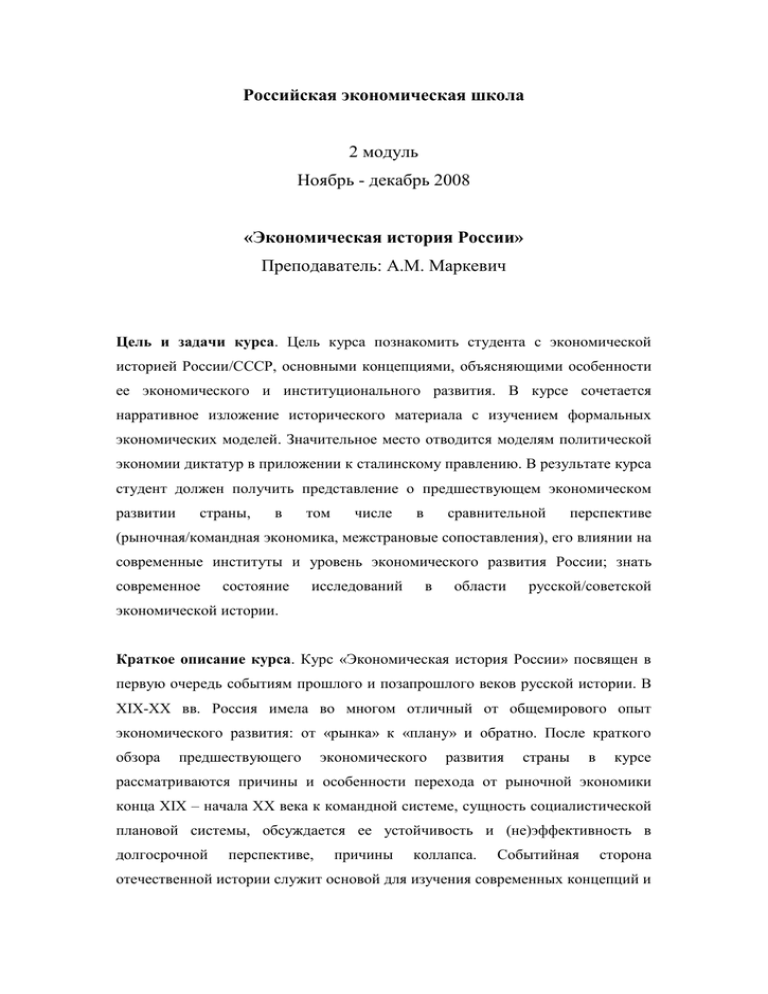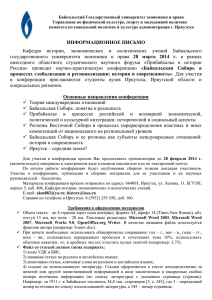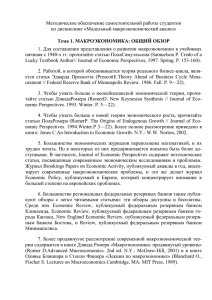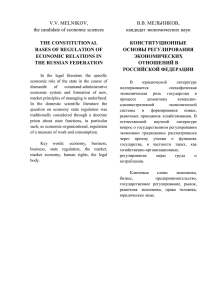Экономическая история России - Российская экономическая школа
реклама

Российская экономическая школа 2 модуль Ноябрь - декабрь 2008 «Экономическая история России» Преподаватель: А.М. Маркевич Цель и задачи курса. Цель курса познакомить студента с экономической историей России/СССР, основными концепциями, объясняющими особенности ее экономического и институционального развития. В курсе сочетается нарративное изложение исторического материала с изучением формальных экономических моделей. Значительное место отводится моделям политической экономии диктатур в приложении к сталинскому правлению. В результате курса студент должен получить представление о предшествующем экономическом развитии страны, в том числе в сравнительной перспективе (рыночная/командная экономика, межстрановые сопоставления), его влиянии на современные институты и уровень экономического развития России; знать современное состояние исследований в области русской/советской экономической истории. Краткое описание курса. Курс «Экономическая история России» посвящен в первую очередь событиям прошлого и позапрошлого веков русской истории. В XIX-XX вв. Россия имела во многом отличный от общемирового опыт экономического развития: от «рынка» к «плану» и обратно. После краткого обзора предшествующего экономического развития страны в курсе рассматриваются причины и особенности перехода от рыночной экономики конца XIX – начала XX века к командной системе, сущность социалистической плановой системы, обсуждается ее устойчивость и (не)эффективность в долгосрочной перспективе, причины коллапса. Событийная сторона отечественной истории служит основой для изучения современных концепций и моделей, предлагаемых для понимания российского экономического опыта. Особое внимание уделяется новейшим работам, посвященным политической экономии сталинизма, появившимся в результате открытия ранее секретных советских архивов. Система оценивания. Оценка за курс складывается из оценок за итоговый экзамен (80%) и рефератов четырех статей (20%). Рефераты сдаются в конце 3, 4, 5 и 6 недели. Экзамен состоит из двух частей: тестовых вопросов (30%) и 2 открытых мини-эссе (50%). Темы для эссе можно выбрать из предложенного списка. Ограничение: выбранные темы должны относиться к разным частям курса: рыночной и командной моделям российской экономики, соответственно. Словарный лимит каждого эссе 1500 слов. Длительность экзамена 3 часа. Основная литература. Ни один из существующих учебников не соответствует программе курса полностью. Монографии и учебники из списка, приведенного ниже, покрывают отдельные разделы курса и могут быть также использованы в качестве иллюстративного чтения. Дополнительная литература приведена ниже для каждой лекции отдельно. Обязательное чтение помечено звездочкой. Самостоятельное чтение – важная часть курса, при оценивании эссе и ответов на тесты знание обязательной литературы предполагается. Российская экономика периода империи: Gatrell, Peter. The Tsarist Economy, 1850-1917. London, 1986. Далее Gatrell. Грегори, Пол. Экономический рост Российской империи (конец XIX - начало ХХ века): Новые подсчеты и оценки. М.: Росспэн. 2003. (Компилятивный перевод Gregory, Paul R. Russian National Income, 1885 – 1913 Cambridge: Cambridge University Press, 1982 и Gregory, Paul R. Before Command: an Economic History of Russia from Emancipation to the First Five-Year Plan. 1994). Далее Грегори, 2003. От рынка к плану: Davies, R.W., Mark Harrison, & S.G. Wheatcroft (editors), The economic transformation of the Soviet Union, 1913-1945, Cambridge: Cambridge University Press, 1994. Далее DHW. Сталинская модель командной экономки: Грегори, Пол. Политическая экономия сталинизма. М.: Росспэн, 2006. Перевод Gregory, Paul R. The Political Economy of Stalinism: Evidence from the Secret Soviet Archives, Cambridge: Cambridge University Press, 2003. Далее Грегори, 2006. Gregory, Paul R., and Mark Harrison. "Allocation Under Dictatorship: Research in Stalin's Archives." Journal of Economic Literature 43:3, 2005, pp. 721-61. Лучший обзор новейшей литературы. Далее GH. Поздний социализм и коллапс: Hanson, Phillip. Rise and Fall of the Soviet Economy: An Economic History of the USSR, 1945-1991. Longman: 2004. Далее Hanson. Ellman, Michael E. and Vladimir Kontorovich (editors), The Destruction of the Soviet Economic System: an Insiders’ History, London: M.E. Sharpe, 1998. Далее EK. Общие работы: Гайдар Е. Т. Долгое время. Россия в мире: очерки экономической истории. Москва, Дело, 2005. Кудрин В.М. Национальная экономика России. М.: Дело, 2007. Gregory, Paul R., & Stuart, Robert C., Soviet Economic Structure and Performance, Reading, MA: Harper & Row, 1974, revised 1981, 1986, 1990; revised as Soviet and Post–Soviet Economic Structure and Performance, Reading, MA: HarperCollins, 1994; revised as Russian and Soviet Economic Structure and Performance, Reading, MA: Addison Wesley, 1998, 2001. Далее GS (year). Nove, Alec, An Economic History of the USSR, 1st edn, London: Allen Lane, 1969; revised 1989; revised as An Economic History of the USSR, 1917–1991, London: Penguin Books, 1992. Далее Nove (year). Новейшие статьи по советской экономической истории могут быть найдены на The PERSA Working Papers http://www2.warwick.ac.uk/fac/soc/economics/staff/faculty/harrison/archive/persa/ Историческую экономическую статистику России можно найти на следующих сайтах: http://www.ggdc.net/maddison/ - российский/советский ВВП в международном сопоставлении http://src-home.slav.hokudai.ac.jp/database/SESS.html - советская статистика http://www.hist.msu.ru/Labs/Ecohist/version/r_databa.htm - статистика российской империи и некоторые архивные микроданные. Структура курса. Курс состоит из 14 лекций. 0. Введение (1 лекция). 1. Введение. Цель и задачи курса. Чему может научить история? Обзор курса. Экономическая история России в самом кратком изложении: 1000-2000 гг. н.э. России в мировом контексте. DHW, chapter by Davies, “Changing Economic Systems: an Overview”. Dennison, T.K. (2006) “Did serfdom matter? Russian rural society, 1750 – 1860”, Historical Research, 79 (3), pp. 74-89 Dennison T.K. and S. Ogilvie (2007). “Serfdom and social capital in Bohemia and Russia”, Economic History Review, 60(3), 513–544. story Review0013-0117Economic History Society 20062007 *Dormar, Evsey D. (1970) “The Causes of Slavery or Serfdom: A Hypothesis” The Journal of Economic History, 30 (1), 18-32 GS (2001), ch. 1. Harrison, Mark (2001). “The Russian and Soviet Economy”, in Jonathan Michie, ed., A Reader’s Guide to the Social Sciences, vol. 2, pp. 1441-3. Maddison, Angus, The World Economy: A Millennial Perspective. OECD, 2001. Millward, Robert (1982) “An economic Analysis of the Organisation of Serfdom in Eastern Europe”, The Journal of Economic History, 42(3), 513-548 O Тема 1. Российская империя, как развивающаяся страна (3 лекции) 2. Экономическое развитие России во второй половине XIX-начале ХХ века: успех или провал. Структура экономики и темпы экономического роста до 1917 г. *Грегори, 2003 гл 1,2. Кафенгауз Л.Б. Эволюция промышленного производства России (последняя треть XIX в. - 30-е годы ХХ в.) М., 1994. *Allen, Robert C. Farm to Factory: A Reinterpretation of the Soviet Industrial Revolution. Princeton, N.J.: Princeton University Press, 2004. ch. 2 Dormar E.D., Machina M.J (1984) “On the Profitability of Russian Serfdom”, The Journal of Economic History, 44(4): 919-955 Hoch Steven L., and Wilson R. Augustine (1979) “The Tax Censuses and the Decline of the Serf Population in Imperial Russia, 1833-1858”, Slavic Review, 38 (3), 403425. Gatrell, ch. 2 Gerschenkron, A., “Agrarian Policies and Industrialisation: Russia 1861-1917” in The Cambridge Economic History of Europe” vol. VI. GS (2001), ch. 2. Gregory, Paul R. (1994), Before Command. An Economic History of Russia from Emancipation to the First Five-year Plan, ch. 2. Gregory, Paul R. Russian National Income 1885-1913. Cambridge: Cambridge University Press, 1982. chs 6, 7 Gregory, Paul R. Russian National Income 18851913. Cambridge: Cambridge University Press, 1982. chs 6, 7 Nafziger Stephen, “Democracy under the Tsars? The Case of the Zemstvo”, available at http:// ehameeting.com/pdf/papers/steven-nafziger-paper.pdf Nove (1992), ch 1. 3. Индустриализация: первая волна. Роль государства в дореволюционном экономическом развитии. Бовыкин В.И. Финансовый капитал в России накануне Первой мировой войны М.: Росспэн, 2001. Barkai, Haim (1973), “The Macro-Economics of Tsarist Russia in the industrialization Era: Monetary Developments, the Balance of Payments and the Gold Standard”, The Journal of Economic History, 33 (2): 339-371. Dempster G. (2006) “The fiscal background of the Russian Revolution”, European Review of Economic History, 10: 35-50. Paul Gregory; Joel W. Sailors (1976). Russian Monetary Policy and Industrialization, 1861-1913, The Journal of Economic History, 36 (4): 836-851. *Gregory, Paul R. (1994), Before Command. An Economic History of Russia from Emancipation to the First Five-year Plan, ch. 4. Gatrell, Peter. “Industrial Expansion in Tsarist Russia, 1908-1914”, Economic History Review (Febrary), 1982. Gatrell, ch. 2. Gerschenkron, A., Economic Backwardness in Historical Perspective. Cambridge, MA: Belknap Press of Harvard University Press, 1962. chs 1 Kahan Arcadius (1967), Government Policies and the Industrialisation of Russia, The Journal of Economic Hisotry, 27(4): 460-477 4. Аграрный сектор дореволюционной экономики. Дискуссия об уровне жизни. Ананьич Б.В. Заметки по поводу статьи Б.Н.Миронова "Кто платил за индустриализацию: экономическая политика С.Ю.Витте и благосостояние населения в 1890-1905 гг. по антропометрическим данным". Экономическая история. Ежегодник. 2001. М.: Росспэн, 2003. C. 611-613. Анфимов А.М. Крестьянское хозяйство Европейской России, 1881 – 1904 гг. М. 1980. Давыдов М.Б. Очерки аграрной истории России в конце XIX – начало XX (по материалам транспортной статистики и статистики землеустройства). М., 2003. Миронов Б.Н. Кто платил за индустриализацию: экономическая политика С. Ю. Витте и благосостояние населения в 1890-1905 гг. по антропометрическим данным. Экономическая история. Ежегодник. 2001. М.: Росспэн, 2002. C. 418427. Эллман М. Витте, Миронов и ошибочное использование антропометрических данных. Экономическая история. Обозрение. Выпуск 11. М., 2005. С. 159-166. Gerschenkron, A. “Agrarian Policies and the Industrialization of Russia, 1861-1917”, in H.J. Habbakuk and M.M. Postan, eds., Cambridge Economic History of Europe, vol. 6(2), 1965. Gregory, Paul R. “Grain Marketing and Peasant Consumption, Russia 1885- 1913”, Explorations in Economic History (April), 1980. Gregory, Paul R. “Russian Living Standards during the Industrialization Era, 18851913”, Review of Income and Wealth, 26(1), 1980. *Hoch Stephen, On good numbers and bad: Malthus, Population Trends and Peasant Standard of Living in Late Imperial Russia, Slavic Review 53(1), 1994 Nafziger Stephen, Land redistribution and the Russian Peasant Commune in the 19th Century. Working paper. Available at http://www.ekh.lu.se/ehes/paper/RepartitionsPaper_June2007.pdf Mironov B.N. New Approaches to Old Problems: The Well-Being og the Population of Russia from 1821 to 1910 as Measured by Physical Stature, Slavic Review, 58(1), 1999. Sanders John Thomas (1984) "Once More Into the Breach, Dear Friends": A Closer Look at Indirect Tax Receipts and the Condition of the Russian Peasantry, 18811899”, Slavic Review, 43(4): 657-666. Simms, Jr. James Y. (1974) “The Crisis in Russian Agriculture at the End of the Nineteenth Century: A Different View”, Slavic Review, 36(3): 377-398. Wheatcroft, S.G., (1999) “The Great Leap Upwards: Anthropometric Data and Indicators of Crises and Secular Changes in Soviet Welfare Levels, 1880-1960”, Slavic Review, 58(1), with comments by Hoch and Komlos and replies by Mironov and Wheatcroft Wilbur, Z. (1983) “Was Russian Agriculture Really That Impoverished?” The Journal of Economic History, 43, 1983. Тема 2. Поиск пути экономического развития (3 лекции). 5. Первая мировая война и экономический кризис. Командная экономика «военного коммунизма» и экономический коллапс. Сидоров А. И. Экономическое положение России в годы первой мировой войны. М, 1973. *Chapter by Peter Gatrell in Broadberry Stephen and Mark Harrison (eds). The Economics of World War I. Cambridge: Cambridge University Press, 2005. DHW, chapter by Gatrell, “The First World War and Civil War”. Eloranta Jari and Mark Harrison. Correlates of Mobilization in the Two World Wars. Working paper. 2006. Available at http://www2.warwick.ac.uk/fac/soc/economics/staff/faculty/harrison/papers/correlates .pdf Gatrell, Peter, and Mark Harrison “The Russian and Soviet Economy in Two World Wars”, Economic History Review, 46(3), 1993. Gatrell, Peter. Russia's First World War: A Social and Economic History. London: Longman, 2005. GS (2001), ch. 3. Nove, (1992), ch. 3. 6. Смешанная экономика НЭПа. Бородкин Л.И., Свищев М.А. «Социальная мобильность в период нэпа: к вопросу о росте капитализма из мелкого производства», История СССР, 5, 1990. Грегори, 2006. Гл. 2. Gregory, Paul R. Before Command: an Economic History of Russia from Emancipation to the First Five-Year Plan, Princeton: Princeton University Press, 1994, chs 5-6. Gregory, Paul R., and Mokhtari, Manouchehr. “State Grain Purchases, Relative Prices, and the Soviet Grain Procurement Crisis.” Explorations in Economic History, 30(2), 1993: 182-94. GS (2001), ch. 4. *Johnson, J., and Temin, P., “The Macroeconomics of NEP”, Economic History Review, 46(4), 1993. Harrison, Mark. Prices in the Politburo, 1927: Market Equilibrium Versus the Use of Force. Working paper, 2006. Available at http://www2.warwick.ac.uk/fac/soc/economics/staff/faculty/harrison/papers/politburo. pdf Nove, (1992), ch. 4. 7. Дебаты о дальнейшем развитии. Коллективизация. Davies R. W., M. B. Tauger and S. G. Wheatcroft ‘Stalin, Grain Stocks and the Famine of 1932-1933’ Slavic Review, 54(3), 1995 *Erlich, Alexander. ‘Preobrazhenski and the Economics of Soviet Industrialization’ The Quarterly Journal of Economics, 64(1), 1950. Ellman, Michael. “On a Mistake of Preobrazhensky and Stalin”, Journal of Development Studies, 14(3), 1978. Ellman, Michael. ‘Did the Agricultural Surplus Provide the Resources for the Increase in Investment in the USSR During the First Five Year Plan?’ The Economic Journal, 85(340), 1975 Millar, James R. “Mass Collectivization and the Contribution of Agriculture to the First Five-Year Plan”, Slavic Review, 33(4), 1970; Tauger Mark B., (1991) “ The 1932 Harvest and the Famine of 1933”, Slavic Review, 50(1): 70-89. Тема 3. Советская командная экономика: сталинская модель (4 лекций). 8. Советский «большой прыжок»: индустриализация и экономическое развитие в 1930-е гг. Харрисон М. Промышленное производство в СССР в 1928-1950 гг.: реальный рост, скрытая инфляция и "неизменные цены 1926/1927 гг." Экономическая история. Ежегодник 2001. М.: Росспэн, 2002, C. 293-336. Allen, Robert C., ‘The Standard of Living in the Soviet Union, 1928-1940’, Journal of Economic History, 58(4), 1998: 1063-89. *Allen, Robert C. “Capital Accumulation, the Soft Budget Constraint, and Soviet Industrialisation”, European Review of Economic History, 2(1), 1998: 1-24. Bergson, Abram, The Real National Income of Soviet Russia since 1928, Cambridge: Cambridge University Press, 1961. ch. 14 DHW, chs by Wheatcroft and Davies, “The Crooked Mirror of Soviet Economic Statistics”, Harrison, “National Income”, and Davies, “Industry”. GH GS (2001), ch. 10. Cohen Stephen F.(1973), “Stalin's Revolution Reconsidered” 32(2): 264-270. Harrison Mark (1985, “Investment Mobilization and Capacity Completion in the Chinese and Soviet Economies” Economics of Planning 19(2) *Hunter, H., and Szyrmer, J.M., “Testing Early Soviet Economic Alternatives”, Slavic Review, 50(2), 1991. Hunter, H. (1973) “The Overambitious First Soviet Five-Year Plan”, Slavic Review, 32(2): 237-257. Maddison, Angus, The World Economy: A Millennial Perspective. OECD, 2001. Nove (1992), chs 7-11. Zaleski, Eugene. Stalinist Planning for Economic Growth, 1933-52. Chapel Hill: University of North Carolina Press: 1981, ch. 19. 9. Политическая экономика сталинизма. * Грегори, 2006 особенно гл. 4 Маркевич А.М. Была ли советская экономика плановой? Планирование в наркоматах в 1930-е гг. Экономическая история. Ежегодник. 2003. М.: Росспэн, 2004. Хлевнюк О.В. Политбюро. Механизмы политической власти в 30-е годы. М.: Росспэн, 1996. Barenett, Vincent ‘Understanding Stalinism—The ‘Orwellian Discrepancy’ and the ‘Rational Choice Dictator’ Europe-Asia Studies, 58(3), 2006. Responses by Davies, Wheatcroft and Harrison Barenett, Vincent ‘Debate Stalinist Logic, Excess Morality and the Rational Fool: A Response to Davies, Wheatcroft and Harrison’, Europe-Asia Studies, 59(3), 2007 *Belova, Eugenia and Valery Lazarev. Why party and how much? The Soviet State and the party finance. Source, Public Choice, 130:3-4, March 2007: 437-56. Berliner, J.S. Factory and Manager in the USSR, Harvard University Press, 1957 esp. chs 3, 6-10, 18. Gorlizki Yoram and Oleg Khlevniuk, Cold Peace: Stalin and the Soviet Ruling Circle, 1945–1953,Oxford University Press: Oxford, 2004 Gregory, Paul R. (ed.), Behind the Façade of Stalin’s Command Economy: Evidence from the Soviet State and Party Archives, Hoover Institution Press, 2001. GS (2001), chs 5 to 7. Gregory, Paul R., and Valery Lazarev, “The Wheels of a Command Economy: Allocating Soviet Vehicles”, Economic History Review, 55(2), 2002. Gregory, Paul R., and Andrei Markevich (2002). “Creating Soviet Industry: The House That Stalin Built.” Slavic Review, 61(4), 787-814. GH. Harrison, Mark. “Prices, Planners, and Producers: an Agency Problem in Soviet industry, 1928-1950”, Journal of Economic History, 58 (4), 1998. Nove, Alec. “The Problem of ‘Success Indicators’ in Soviet Industry.” Economica, 25(97), 1958; reprinted in Holzman, F.D., ed. (1962), Readings on the Soviet Economy Nove, Alec Was Stalin Really Necessary? New York, Praeger 1964. Olson, Mancur. “Dictatorship, Democracy, and Development”, American Political Science Review, 87(3), 1993: 567-76. Wintrobe, Ronald. The Political Economy of Dictatorship, Cambridge: Cambridge University Press, 1998. 10. Террор и принудительный труд как свойства системы. Бородкина Л.И., Грегори П., Хлевнюка О.В. (под ред.) Экономика принудительного труда. М.: РОССПЭН, 2005. Дэвис Роберт, Советская экономика и начало Большого террора. Экономическая история. Ежегодник 2006. М.: Росспэн, 2006. История сталинского Гулага. Конец 1920-х — первая половина 1950-х годов: Собрание документов в 7-ми томах. М.: Росспэн, 2004. Belova Eugenia and Paul Gregory. “The Economics of Crime and Punishment Under Stalin”. Working paper. 2006. Ellman, Michael. “Soviet Repression Statistics: Some Comments.” Europe Asia Studies, 54(7), 2002. Gregory Paul R., Sshroder Philipp J.H. and Konstantin Sonin Dictators, Repression and the Median Citizen: An 'Eliminations Model' of Stalin's Terror (Data from the NKVD Archives). Working paper. November, 2006. Available at SSRN: http://ssrn.com/abstract=948667 *Harrison, Mark The Fundamental Problem of Command: Plan and Compliance in a Partially Centralised Economy. Comparative Economic Studies 47:2, 2005: 296-314. Harrison, Mark (2003). “Why Secrets? The Uses of Secrecy in Stalin’s Command Economy.” Department of Economics, University of Warwick, available from www2.warwick.ac.uk/fac/soc/economics/staff/faculty/harrison/papers. Katz, Barbara “Purges and Production: Soviet Economic Growth, 1928-1940.” Journal of Economic History, 35, 1975. Kontorovich, Vladimir, “Discipline and Growth in the Soviet Economy.” Problems of Communism , 34(6), 1986. 11. СССР и Вторая мировая война. Победа в войне, как аргумент в пользу социалистической модели развития. Советский военно-промышленный комплекс. Маркевич А.М. «Нужды обороны и планирование военной промышленности в СССР в конце 1920-х – 1930-е гг.», Экономическая история. Ежегодник. 2007. М.: Росспэн, В печати. Симонов Н.С. Военно-промышленный комплекс СССР в 1920-1950-е годы. М.: Росспэн, 1996. Barber, John, and Mark Harrison. The Soviet Home Front, 1941-5: a Social and Economic History of the USSR in World War II. London: Longman, 1991. Barber, John, and Mark Harrison (eds). The Soviet Defence-Industry Complex from Stalin to Khrushchev. Basingstoke and London: Macmillan Press, 2000. DHW chapter by Harrison, “The Second World War”. Gatrell, Peter, and Mark Harrison “The Russian and Soviet Economy in Two World Wars”, The Economic History Review, 46(3), 1993. Gregory, Paul R. “Why Was Soviet Defense Planning So Far Off the Mark?” EuropeAsia Studies, 58(8), 2003. Harrison Mark. “The Political Economy of a Soviet Military R&D Failure: Steam Power for Aviation, 1932 to1939.” Journal of Economic History, 63(1), 2003. Harrison Mark Accounting for War: Soviet Production, Employment, and the Defence Burden, 1940-1945. Cambridge: Cambridge University Press, 1996. *Harrison, Mark (ed). Guns and Rubbles. Soviet Military Industrial Complex under Stalin. Yale University Press, 2008. Especially ch.1 Markevich Andrei and Mark Harrison Quality, Experience, and Monopoly: the Soviet Market for Weapons Under Stalin. Economic History Review 59:1, 2006, pp. 113-142. Тема 4 Поздний социализм (3 лекции). 12. Послевоенное развитие. Замедление темпов экономического роста. Allen, Robert C. Farm to Factory: A Reinterpretation of the Soviet Industrial Revolution. Princeton, N.J.: Princeton University Press, 2004. Bergson, Abram. “The USSR Before the Fall: How Poor and Why.” Journal of Economic Perspectives, 5(4), 1991. Dearden, J., Ickes, B.W., and Samuelson, L. “To Innovate or Not to Innovate: Incentives and Innovation in Hierarchies.” American Economic Review, 80(5), 1990. Easterly, William, and Fischer, Stan. “The Soviet Economic Decline.” World Bank Economic Review, 9(3), 1995. GS. (1994), ch. 10. Harrison, Mark, “Trends in Soviet Labour Productivity, 1928-1985: War, Postwar Recovery, and Slowdown”, European Review of Economic History, 2(2), 1998. Kontorovich, Vladimir “The Soviet Investment Process and Capital-Labor Substitution.” In John P. Hardt and Carl H. MacMillan, eds, Planned Economies: Confronting the Challenges of the 1980s. Cambridge: Cambridge University, 1988 Maddison, Angus, The World Economy: A Millennial Perspective. OECD, 2001. *Ofer, Gur.“Soviet Economic Growth: 1928-1985.” Journal of Economic Literature, 25, 1987. Rosefielde Steven.“The Riddle of Post-war Russian Economic Growth: Statistics Lied and Were Misconstrued,” Europe-Asia Studies, 55(3), 2003; reply by Mark Harrison “Postwar Russian Economic Growth: Not a Riddle.” Europe-Asia Studies, 55(8), 2003. *Weitzman, Martin L. “Soviet Postwar Growth and Capital-Labor Substitutability.” American Economic Review, 60, 1970 pp. 676-692. 13. Экономика дефицита и мягких бюджетных ограничений. Предприятия и домохозяйства в советской системе. Вынужденные накопления. Корнаи, Януш. Экономика дефицита. М., 1990. Birman, Igor, and Roger A. Clarke “Inflation and the Money Supply in the Soviet Economy.” Soviet Studies, 37(4), 1985. Paul R. Gregory (1982), “Fertility and Labor Force Participation in the Soviet Union and Eastern Europe”, The Review of Economics and Statistics, 64(1): 18-31. *Harrison, Mark, and Kim, Byung-Yeon. Plans, Prices, and Corruption: The Soviet Firm Under Partial Centralization, 1930 to 1990. Journal of Economic History 66:1 (2006), pp. 1-41. Kim, Byung-Yeon, “The Income, Savings, and Monetary Overhang of Soviet Households.” Journal of Comparative Economics, 27, 1999. Kim, Byung-Yeon. “Causes of Repressed Inflation in the Soviet Consumer Market: Retail Price Subsidies, the Siphoning Effect, and the Budget Deficit.” Economic History Review, 55(1), 2002: 105-127. Kim, Byung-Yeon (1997), “Soviet Household Saving Function”, Economics of Planning 30: 181–203, 1997. 181 Gomulka, Stanislaw. “Kornai’s Soft Budget Constraint and the Shortage Phenomenon: a Critique and Restatement”, Economics of Planning, 19(1), 1985; reply by Kornai, Economics of Planning, 19(2), 1985. Gregory, Paul R., and Tikhonov, Aleksei. “Central Planning and Unintended Consequences: Creating the Soviet Financial System, 1930-1939.” Journal of Economic History, 60(4), 2000. Shleifer, Andrei, and Robert W. Vishny. “Pervasive Shortages under Socialism.” RAND Journal of Economics, 23(2), 1992. Offer Gur and Joyce Pickergill Soviet Household Sving : A cross-section Study of Soviet Emigrant Families, The Quarterly Journal of Economics, 95(1), 1980: 121-144 Joyce Pickergill Soviet Household Saving Behavior, The Review of Economics and Sttistics, 58(2), 1976: 139-147 14. Коллапс советской системы: кто виноват «лошадь» или «жокей»? *Берлинер Джозеф. Кто виноват «лошадь» или «жокей»? Экономическая история. Ежегодник 2003. М., 2004. *Грегори, 2006. Гл. 10 Гайдар Е.Т. Гибель империи. Уроки для современной России. М.: Росспэн, 2006. Anderson, Gary M., and Peter J. Boettke (1997), “Soviet Venality: a Rent-Seeking Model of the Communist State.” Public Choice, 93(1-2). Belova, Eugenia, and Paul R. Gregory (2002). “Dictators, Loyal and Opportunistic Agents: the Soviet Archives on Creating the Soviet Economic System.” Public Choice, 113(3-4). Bergson Abram, (1991) “The USSR Before the Fall: How Poor and Why”, The Journal of Economic Perspectives, 5(4): 29-44. Dallin, A. “Causes of the Collapse of the USSR.” Post-Soviet Affairs, 8(4), 1992. Ellman, Michael, and Vladimir Kontorovich, (eds), The Disintegration of the Soviet Economic System New York: Routledge, 1992 (chapter by Ellman, “Money in the 1980s: from Disequilibrium to Collapse”). GS (1994), ch. 13. Harrison, Mark “Coercion, Compliance, and the Collapse of the Soviet Command Economy.” Economic History Review, 55(3), 2002. Murphy, Kevin M., Andrei Shleifer, and Robert W. Vyshny. “Why is Rent-Seeking so Costly to Growth?” American Economic Review Papers & Proceedings, 83(2), 1993.


